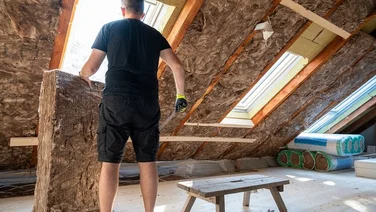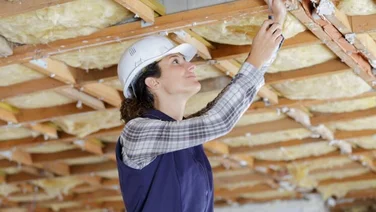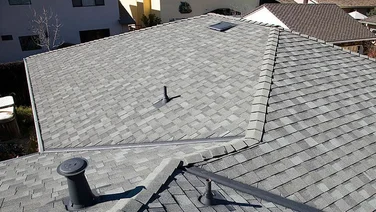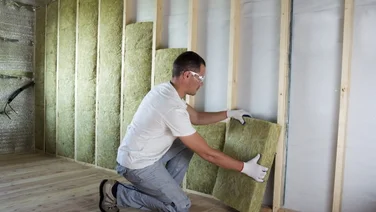- What is spray foam insulation?
- Where can you put spray foam insulation?
- What are the benefits of spray foam insulation?
- How much does spray foam insulation cost?
- What is the R rating of spray foam insulation?
- How many UK homes have spray foam insulation?
- Spray foam insulation compared to other types of insulation
- Summary
✔ Spray foam is the best insulation at keeping heat inside your home
✔ It’s 2.7 times better at insulating your property than fibreglass
✔ Spray foam can also act as effective sound insulation
Spray foam insulation costs a decent amount of money, but it can make your home more energy-efficient, help it stay warm in the winter, cool in the summer, and cut your energy bills while reducing your carbon footprint
It’s significantly better than fibreglass insulation at keeping heat in – and out – which should give you some welcome relief from soaring energy costs.
If you’re ready to enjoy the many benefits of spray foam insulation, just fill in this quick form and our expert suppliers will be in touch with free quotes.
Get free spray foam insulation quotes
Answer a few quick questions, and our trusted installers will send you bespoke spray foam insulation quotes – for free.

What is spray foam insulation?
Spray foam insulation, also known as spray polyurethane foam, is a liquid insulation.
You can get a professional to use spray foam to insulate your floors, loft, roof, or walls.
After taking the appropriate safety measures, they’ll spray the substance – made of isocyanate and polyol resin – onto your chosen location, and it’ll expand to at least 30 times its size, forming a solid layer of insulation that looks like a cloud.
Otto Bayer created polyurethane in 1937, and it quickly became a common material in all kinds of products, from car seats and baby mattresses to bungee cords.
20.5 million tonnes of polyurethane goods are now exported across the world per year, to the tune of £4.8 billion.
Icynene open cell spray foam insulation
There are two main ways of installing spray foam insulation – open cell and closed cell – and Canadian company Icynene is the market leader in both.
Of the two, open cell is the softer, more flexible, and (usually) cheaper option.
It’s not as good at insulating your home as the closed cell version, so your specialist installer will need to spray a thicker coat to achieve the same level of insulation.
However, it does act as sound insulation, which is great if – for instance – your teenager likes to play loud music in their loft bedroom.
This is because open cell foam stops airflow in its tracks, meaning it blocks air – and therefore sound – from travelling from one room to another.
And if you find yourself accidentally bumping into walls a lot, the squashy, accommodating nature of open cell foam will help you to avoid scrapes and bruises.
Icynene closed cell spray foam insulation
Closed cell spray is better at insulating your home than open cell foam, as it forms a solid barrier between your home and the cold winds of the outside world.
Instead of air, closed cell foam contains gases – hydrofluorocarbons or hydrochlorofluoro-olefins – which were created to replace ozone layer-depleting chemicals like chlorofluorocarbons.
These chemicals form pockets of gas that make it much harder for heat to pass through, which allows your home to stay warmer in winter and cooler in summer.
However, closed cell spray also stops moisture from passing through, so make sure your home is well-ventilated to prevent condensation.
Where can you put spray foam insulation?
You can install spray foam insulation anywhere that you can install other kinds of insulation: your attic, floors, roof, and walls.
And if you have any left over, you can even use it to secure a wobbly pipe or shower head.
Spray foam insulation for attics and roofs
25% of the heat that escapes your home makes its way out of your roof, according to the Energy Saving Trust – which partly explains why your attic can be one of the coldest places in your home.
The best way to fix these problems is with spray foam insulation.
Insulating your roof saves the average semi-detached house £355 per year – a huge reduction in your energy costs – and can cut your carbon footprint by 11%.
And using spray foam means you should be able to use more of your attic space, because spray foam is better at insulating your home, per centimetre, than fibreglass.
So whether you want to use your attic for storage or turn it into a bedroom or games room, you’ll have more space to play with if you choose spray foam insulation.

Spray foam insulation for walls
Your professional installer will advise you on whether they think open or closed cell spray foam would be better for your home.
Once you’ve agreed on an approach, they’ll spray the foam and it’ll instantly expand, covering gaps that other kinds of insulation often leave.
Insulating your walls in a semi-detached house will typically cut your energy bills by £540 per year.
Homes in the UK lose heat more quickly than homes in every other Western European nation, according to a Tado study – and three times faster than in Germany.
And since walls are responsible for 35% of your heat loss – more than your windows, roof, or floors – they’re the key to slashing your energy bills.
What are the benefits of spray foam insulation?
Spray foam insulation can help you to:
- Keep warmth inside your home more effectively than fibreglass insulation
- Insulate hard-to-reach areas
- Improve that room’s soundproofing
- Potentially add structural integrity to your home
- Prevent draughts, as its seals are airtight
- Stop pollen and other allergens from entering your home
- Cut hundreds of pounds off your energy bills
We also have a page on how to address the key problems with spray foam insulation, with guidance on how to solve them.
How much does spray foam insulation cost?
Spray foam insulation costs between £20 and £50 per square metre, according to the National Insulation Association.
Closed cell foam is more expensive than open cell spray, and as you’d expect, it’ll cost less if your insulation layer is thinner, and more if it’s thicker.
Your cost will also be affected by how difficult the job is, and how much spray foam is needed to cover the relevant surfaces.
Spray foam can end up being more expensive than other common forms of insulation, with fibreglass and insulation boards both costing around £20 per square metre – but it can be more than worth it.
Some people try to reduce these costs by trying DIY spray foam kits, but we wouldn’t recommend doing this. Not only could you damage your property, but you could also risk your health.
If you’d like to see whether spray foam insulation is the right choice for your home, just fill in this quick form and our specialists will contact you with free quotes.
What is the R rating of spray foam insulation?
Wondering whether spray foam insulation is worth it? Well, the average R rating – or R-Value – of spray foam insulation is between 5.6 and 8 per inch, with closed cell foam achieving the highest ratings.
This is much higher than other forms of insulation.
Fibreglass, for instance, has a typical R rating of 2.2 to 2.9 per inch.
And cellulose insulation’s R rating is usually between 3.1 and 3.8 per inch.
That means you won’t have to install as much spray foam insulation to reach the same levels of warmth and comfort – leaving you more space in your home that you can use.
How many UK homes have spray foam insulation?
250,000 UK homes have spray foam insulation.
This shows the growing popularity of this form of insulation, considering it only started to become commonly used in this country during the 1980s.
With the government encouraging homeowners to cut their emissions, we can expect spray foam to be used in many more houses over the next decade.
Spray foam insulation compared to other types of insulation
Spray foam insulation’s R rating of 5.6 to 8 per inch places it well above other types of insulation.
On average, it’s 2.7 times better at keeping warm air inside your home than fibreglass, and two times better than cellulose.
And you can use spray foam in difficult-to-access areas that other forms of insulation can’t reach.
This means you can insulate spots that wouldn’t have otherwise been covered, and with spray foam’s airtight seals, you can prevent draughts and heat loss to a much higher degree than with other types of insulation.
The only downside of spray foam when compared to other insulation methods is that it’ll typically cost about £15 more per inch – but when it comes to your home, it makes sense to pay for the best.
Summary
Spray foam insulation is an extremely effective, space-efficient way of insulating your home.
You’ll be able to keep more warmth inside, and reduce cold draughts and allergens like pollen blowing in from the outside.
And with its easy application, your installer will be able to form airtight seals in hard-to-reach areas that other types of insulation can’t touch.
Want to see how much spray foam insulation would cost for your home? Just enter a few details, and our excellent suppliers will be in touch with free quotes.






